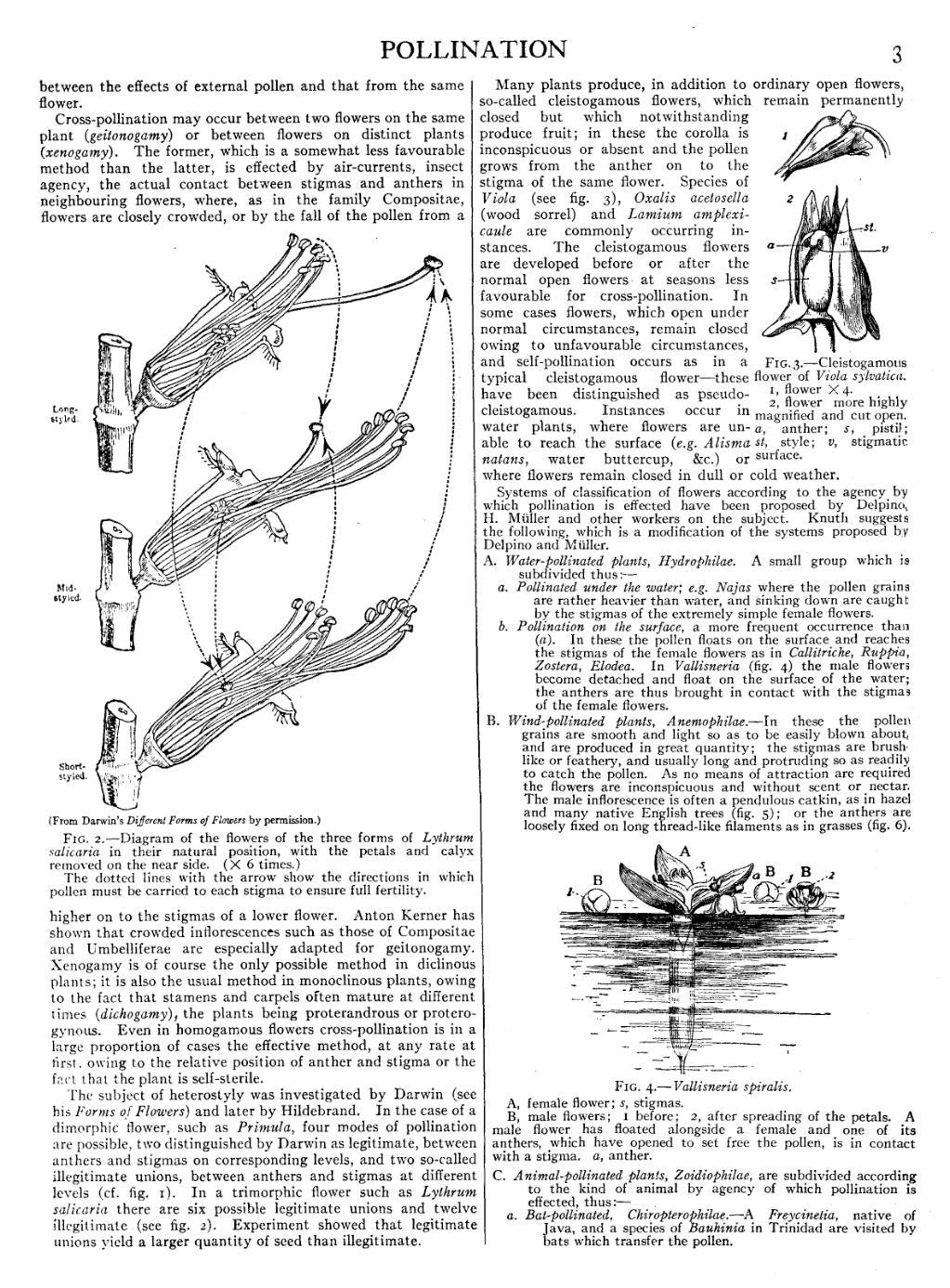between the effects of external pollen and that from the same flower.
Cross-pollination may occur between two flowers on the same plant (geitonogamy) or between flowers on distinct plants (xenogamy). The former, which is a somewhat less favourable method than the latter, is effected by air-currents, insect agency, the actual contact between stigmas and anthers in neighbouring flowers, where, as in the family Compositae, flowers are closely crowded, or by the fall of the pollen from a higher on to the stigmas of a lower flower. Anton Kerner has shown that crowded inflorescences such as those of Compositae and Umbelliferae are especially adapted for geitonogamy. Xenogamy is of course the only possible method in diclinous plants; it is also the usual method in monoclinous plants, owing to the fact that stamens and carpels often mature at different times (dichogomy), the plants being proterandrous or proterogynous. Even in homogamous flowers cross-pollination is in a large proportion of cases the effective method, at any rate at first, owing to the relative position of anther and stigma or the fact that the plant is self-sterile.
The subject of heterostyly was investigated by Darwin (see his Forms of Flowers) and later by Hildebrand. In the case of a dimorphic flower, such as Primula, four modes of pollination are possible, two distinguished by Darwin as legitimate, between anthers and stigmas on corresponding levels, and two so-called illegitimate unions, between anthers and stigmas at different levels (cf. fig. 1). In a trimorphic flower such as Lythrum salicaria there are six possible legitimate unions and twelve illegitimate (see fig. 2). Experiment showed that legitimate unions yield a larger quantity of seed than illegitimate.

|
|
Fig. 3.—Cleistogamous flower of Viola sylvatica. |
|
1, flower × 4. |
|
2, flower more highly magnified and cut open. a, anther; s, pistil; st, style; v, stigmatic surface. |
Many plants produce, in addition to ordinary open flowers, so-called cleistogamous flowers, which remain permanently closed but which notwithstanding produce fruit; in these the corolla is inconspicuous or absent and the pollen grows from the anther on to the stigma of the same flower. Species of Viola (see fig. 3), Oxalis acetosella (wood sorrel) and Lamium amplexicaule are commonly occurring instances. The cleistogamous flowers are developed before or after the normal open flowers at seasons less favourable for cross-pollination. In some cases flowers, which open under normal circumstances, remain closed owing to unfavourable circumstances, and self-pollination occurs as in a typical cleistogamous flower—these have been distingu1shed as pseudocleistogamous. Instances occur in water plants, where flowers are unable to reach the surface (e.g. Alisma natans, water buttercup, &c.) or where flowers remain closed in dull or cold weather.
Systems of classification of flowers according to the agency by which pollination is effected have been proposed by Delpino, H. Müller and other workers on the subject. Knuth suggests the following, which is a modification of the systems proposed by Delpino and Müller.
| A. | Water-pollinated plants, Hydrophilae. A small group which is subdivided thus: — | ||||
| a. | Pollinated under the water; e.g. Najas where the pollen grains are rather heavier than water, and sinking down are caught by the stigmas of the extremely simple female flowers. | ||||
| b. | Pollination on the surface, a more frequent occurrence than (a). In these the pollen floats on the surface and reaches the stigmas of the female flowers as in Callitriche, Ruppia, Zostera, Elodea. In Vallisneria (fig. 4) the male flowers become detached and float on the surface of the water; the anthers are thus brought in contact with the stigmas of the female flowers. | ||||
| B. | Wind-pollinated plants, Anemophilae.—In these the pollen grains are smooth and light so as to be easily blown about, and are produced in great quantity; the stigmas are brush-like or feathery, and usually long and protruding so as readily to catch the pollen. As no means of attraction are required the flowers are inconspicuous and without scent or nectar. The male inflorescence is often a pendulous catkin, as in hazel and many native English trees (fig. 5); or the anthers are loosely fixed on long thread-like filaments as in grasses (fig. 6). | ||||
| C. | Animal-pollinated plants, Zoidiophilae, are subdivided according to the kind of animal by agency of which pollination is effected, thus:— | ||||
| a. | Bat-pollinated, Chiropterophilae.—A Freycinetia, native of Java, and a species of Bauhinia in Trinidad are visited by bats which transfer the pollen. | ||||


